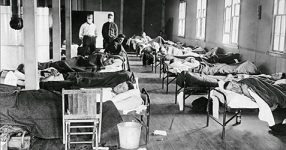The documentary “The Healthcare Divide” sheds light on the profound disparities in healthcare experienced by different communities, particularly during the COVID-19 pandemic. The title indicates a division in the accessibility and quality of healthcare services, emphasizing the challenges faced by safety net hospitals. These medical institutions, primarily funded by the government, play a crucial role in catering to the needs of the poor and uninsured.
In Los Angeles County, the opening scenes vividly portray the severity of the situation during the winter COVID surge. The L.A. County+U.S.C. Medical Center in East L.A. becomes a focal point, revealing the strain on safety net hospitals dealing with an overwhelming number of COVID patients. The emotional moments within the hospital, such as families saying their goodbyes, highlight the grim reality faced by these institutions.
The documentary delves into the systemic issues exposed by the pandemic, unveiling racial disparities in medical outcomes. The focus then shifts to safety net hospitals, institutions tasked with caring for vulnerable populations, including the working poor, homeless individuals, and those with mental health and substance abuse disorders. The film questions why safety nets, despite their critical role, are struggling, even before the pandemic.
The Struggle of Safety Net Hospitals: Financial Challenges and Closures
More than 70 million Americans rely on Medicaid, and approximately 30 million have no insurance. However, safety net hospitals, designed to serve these populations, find themselves in crisis. The documentary spotlights protests against the closure of safety net hospitals like Westlake and Hahnemann University, revealing the precarious financial situation these institutions face. Even before the pandemic, many safety nets were losing money, and the film explores the reasons behind their financial struggles.
The documentary raises questions about the stark contrast between safety net hospitals and more profitable counterparts. It features interviews where frontline and NPR investigate why some hospital systems, like HCA, can generate substantial profits during a pandemic, while safety nets are on the brink of closure. The complexities of the healthcare system and its lack of coherence become evident, prompting a deeper exploration of the challenges faced by safety nets in competing for insured patients.
Erlanger’s Story: A Safety Net Hospital’s Struggle for Survival
The film takes a closer look at Erlanger, a safety net hospital in Chattanooga, Tennessee, to illustrate the broader issues faced by such institutions. Erlanger’s attempts to expand, attract insured patients, and compete with for-profit hospital chains are explored. The narrative unfolds, revealing how Erlanger’s strategy to gain market share and offer high-margin procedures ultimately leads to financial crisis.
Former Senator Bob Corker, who witnessed Erlanger’s challenges during his tenure as the mayor, reflects on the difficulties faced by safety net hospitals. The film exposes the limitations imposed by the safety net hospital mission and the inherent challenges in providing targeted healthcare. It becomes evident that while for-profit hospitals thrive, safety nets struggle due to their commitment to vulnerable populations, exacerbating the healthcare divide.
For-Profit vs. Non-Profit: The Divergence in Hospital Success
The documentary broadens its focus to explore the broader healthcare landscape, comparing for-profit and nonprofit hospital systems. The success of for-profit hospital chains like HCA, Memorial, and Erlanger’s struggle in a competitive environment is analyzed. The film introduces voices such as Jeff Goldsmith, a consultant with HCA, who highlights the operating discipline and focus that contribute to the success of for-profit hospitals.
The historical development of both for-profit and nonprofit hospital systems is discussed, emphasizing how they aimed to address similar challenges. The film underscores the role of geography and social policy in shaping the fate of hospitals. It challenges the notion of hospitals making too much profit and redirects the conversation to societal inequities, suggesting a need for broader policy changes rather than blaming individual hospitals.
Medicaid, Supplementals, and the Black Box of Hospital Funding
The documentary explores the financial intricacies of safety net hospitals, particularly their heavy reliance on Medicaid, a program that often fails to cover the full cost of services. The film raises concerns about the lack of transparency in supplemental payments, a crucial source of income for safety nets. The black box nature of these payments prompts questions about the equitable distribution and utilization of funds.
Frontline and NPR’s attempts to scrutinize how money flows to hospitals in Chattanooga reveal the challenges in understanding the allocation of supplemental payments. The film highlights the divergence in profit margins among hospitals and attributes this gap to the inadequacies of Medicaid reimbursement. The financial struggles of safety nets are further compounded by the lack of clarity in the distribution of supplemental funds.
Private Equity’s Role: Savior or Exploiter?
The documentary takes a controversial turn by examining the role of private equity in healthcare, focusing on Prospect Medical Holdings’ acquisition of safety net hospitals. Interviews with hospital staff and clergy members reveal the initial optimism surrounding private equity investments and how promises of financial stability turned into a disillusionment. The film exposes a pattern of conduct, including violations found in Prospect’s hospitals in California.
The entry of private equity into the healthcare industry is discussed as part of a broader trend seeking high-margin returns. The film underscores how private equity investments may compromise patient care and exacerbate the challenges faced by safety net hospitals. Even those who acknowledge the need for change suggest that drastic measures might be required to secure funding for struggling hospitals, raising ethical questions about the involvement of investors in healthcare.
The Complexity of Healthcare Solutions and the Call for Policy Change
As the documentary concludes, it grapples with the complexities of finding sustainable solutions for safety net hospitals. It advocates for Medicaid expansion but recognizes its limitations in covering the full cost of services. The film challenges viewers to question whether blaming hospitals for following the rules set by the system is justified or if the real issue lies in societal inequities and the failure of social policy and politics.
The closing scenes emphasize the need for systemic change, urging viewers to consider whether they should be mad at hospitals for playing by the rules or if the rules themselves need to be changed. The documentary, “The Healthcare Divide”, leaves the audience with a thought-provoking exploration of the healthcare divide and the urgent need for comprehensive policy reforms to address the inequities in America’s healthcare system.












